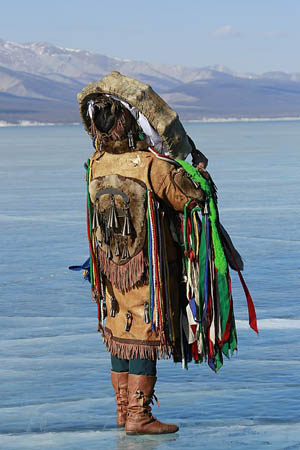


Shamanism is the most ancient and most enduring spiritual tradition known to humanity. It predates and constitutes the foundation of all known religions or religious philosophies. One could view shamanism as the universal spiritual wisdom inherent to all indigenous peoples. It originated among nomadic hunting and gathering societies. These ancient shamanic ways have withstood the tests of time, varying little from culture to culture. Over thousands of years of trial and error, primal peoples the world over developed the same basic principles and techniques of shamanic power and healing. A whole way of life evolved that was based on everything being in right relationship. At the heart of shamanism are the following core beliefs:
1. Everything is interrelated and interdependent. If one species suffers, all others are affected. The health and well-being of humanity is, therefore, dependent upon the overall health of the sentient web of life. The shamanic practitioner is sensitive to this sacred interrelationship and serves as a bridge, linking the human and natural realms. The practitioner's prayerful communion with the natural elements and powers preserves an orderly, harmonious universe.
2. The natural world has two aspects: ordinary everyday awareness, formed by our habitual behaviors, patterns of belief, social norms, and cultural conditioning, and a second non-ordinary awareness accessed through altered states, or trance, induced by shamanic practices such as repetitive drumming. In a non-ordinary state of consciousness, the universe can appear fluid and nonlinear, moral absolutes vanish, death is but a transition and life exists in a variety of forms. Ordinary reality is matter-oriented, while non-ordinary reality is spirit-oriented.
3. Everything is alive and has a spirit. Shamanism is a way of perceiving the nature of the universe in a way that incorporates the normally invisible world where the spirits of all material things dwell. Shamans have different terms and phrases for the unseen world, but most of them clearly imply that it is the realm where the spirits of the land, animals, ancestors, and other spiritual entities dwell. Spirit encompasses all the immaterial forms of life energy that surround us. We are woven together into a net of life energies that are all around us. These energies can appear to us in different forms, such as spirits of nature, animals, or ancestors. The spirit world is the web of life itself.
4. Shamanic practitioners can access other realms of reality. Practitioners employ methods for altering consciousness so that they can send their souls into non-ordinary reality. The act of sending one's soul into non-ordinary reality is called the soul flight or shamanic journey, and it allows the journeyer to view life and life's problems from a detached, spiritual perspective not easily achieved in a state of ordinary consciousness. One of the most universal methods for altering consciousness for this spirit journey is a persistent, mesmerizing drumbeat.
5. Non-ordinary reality is more real than ordinary reality. When a shamanic practitioner enters non-ordinary reality, it is to obtain clarity and understanding about something in the everyday world that is not understood (e.g., Why am I sick? Why did this misfortune happen to me? How can I bring healing to myself and others? What is my mission and purpose in life?). Consequently, that is why shamanic journeying is sometimes called "going to the source." And that makes non-ordinary reality more authentic or real.
6. There are three inner planes of consciousness: the Upper, Middle, and Lower Worlds. The three realms are linked together by a vertical axis that is commonly referred to as the cosmic axis or World Tree. The roots of the World Tree touch the Lower World. Its trunk is the Middle World and its branches hold up the Upper World. This central axis exists within each of us. Through the sound of the drum, which is invariably made of wood from the World Tree, the shamanic practitioner is transported to the axis within and conveyed from plane to plane.
7. The purpose of shamanic ritual is to engage the spirit world to effect specific changes in the physical world. The ordinary and non-ordinary worlds interact continuously, and a shamanic practitioner can gain knowledge about how to alter ordinary reality by taking direct action in the non-ordinary aspect of the world. From a shamanic perspective, all human experience is self-generated. Experience is shaped from within since the three realms or resonant fields that define our experience of reality exist within each of us. Each human being is a hologram of the universe. Essentially, we are the universe experiencing itself in human form.
8. Shamanism is based on the principle that innate wisdom and guidance can be accessed through the inner senses in ecstatic trance. The essence of shamanism is the experience of direct revelation from within. Shamanism is about remembering, exploring, and developing the true self. Shamanism places emphasis on the individual, of breaking free and discovering your own uniqueness in order to bring something new back to the group. Shamanic practice heightens the ability of perception and enables you to see into the deeper realms of the self. Once connected with your inner self you can find help, healing, and a continual source of guidance. To practice shamanism is to reconnect with your deepest core values and your highest vision of who you are and why you are here.
* Photo of Mongol Darkhad shaman performing shamanic ritual by Munkhbayar.B is licensed under CC BY-SA 4.0.
Preview our Digital Books and Music
Affiliate disclosure: As an Amazon Associate, we earn from qualifying purchases. You can learn more about our editorial and affiliate policy here. Music Attribution.
© 2001 - 2025 Talking Drum Publications